Jews of Two Worlds: Indians in Israel
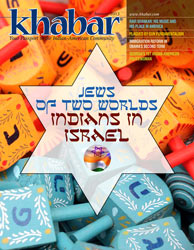
India is one of the rare countries in the world where Jews have never experienced anti-Semitism. Indian Jews now living in their “fatherland” of Israel share nostalgic memories of their rich history and culture in India.
“I am happy to have had the recognition in my life of my two countries, India and Israel, my motherland and my fatherland,” said eighty-two year old Eliyahu Bezalel, winner of India’s Pravasi Bharatiya Samman Award (2006) for overseas Indians. Remembering a day in Cochin when he was a boy of 10, he said, “I got up in class and shouted anti-British slogans. The teacher beat me and threw me out of the class.”
The old man laughed, and in laughing became a young man. The Indian-radio-technician-turned-Israeli-farmer, famous for his achievements in greenhouse flower gardening, marveled that his greenhouse in Israel was visited both by former Indian Prime Minister H.D. Deve Gowda and Israeli Prime Minister and legendary first leader David Ben-Gurion.
Eliyahu left Cochin in 1954, at age 25, excited by the thought of becoming a new man in the new Jewish state.
The origins of the Cochini Jewish community are said by some to date back to the time of King Solomon’s spice trade. The Bene Israel of Maharashtra, washed ashore on the Konkan Coast as a result of a shipwreck that is believed to have occurred sometime between the first and the third century BC, are presumed to belong to the tribe of Levi, being oil pressers as the Levites were.
The Baghdadis, India’s most recent Jewish community, came from Syria, Iraq, and Iran as traders in the late 17th and early 18th centuries. Shalom Cohen, the first Jew of Calcutta, docked in 1685 to become the court jeweler of the Nawab of Oudh. A better known Baghdadi was David Sassoon, builder of the Sassoon Docks in Bombay in the 19th century. The Baghdadis settled primarily in Calcutta, Bombay, and Pune.
There are an estimated 70,000 Indian Jews living in Israel today (the great majority of them Bene Israel), a little less than one percent of Israel’s population. In India, few remain. The Bene Israel are now barely 5,000, if that, where once they numbered upwards of 50,000. The Baghdadis, maybe 5,000 before Partition, have dropped to the low double digits in Calcutta, with handfuls still hanging on in Western India. The Cochinis, also in the low double digits, totter on the rim of extinction. Never very large, virtually all 2,000 of them left for Israel in the years following its creation in 1948.
Fearful that the heritage of Indian Judaism will die out with the death of the last Jew in the subcontinent, Ruth Greenfield, 51, a Bene Israel, recently decided to collect, catalog, and digitize information on India’s Jews for future generations. (Eventually, this will include Pakistani and Burmese Jews.) Her efforts led to the founding of the Indian Jewish Heritage Center.
“My father was an architect in Delhi who was working on preserving our people’s history in India. When he died in 2005, I was inspired to do the work that he began.”
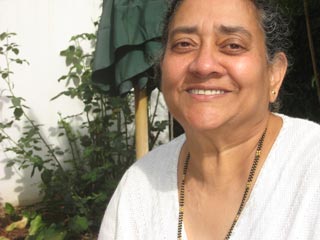
Sophie Judah, author of Dropped from Heaven, a book about the Bene Israel in India.
Sophie Judah, a 63-year-old Bene Israel author whose book of short stories, Dropped from Heaven, was published by Shocken (2007), is a gracious woman who with impeccable hospitality offers her guest a chicken curry and something cold to drink. Her book, a rare work of storytelling about the Bene Israel in India, is unusual for yet another reason: the Bene Israel (also the Cochinis) existed outside the Jewish norm of a written tradition. The Baghdadis alone have sojourned in India with a written tradition brought with them from the crossroads of the Middle East.
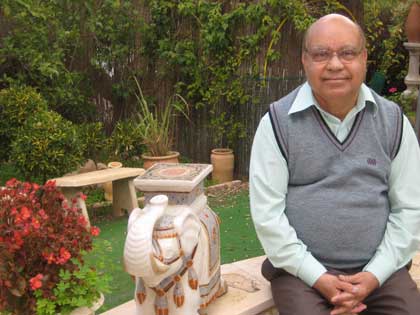
Noah Massil, president of the Central Organization of Indian Jews, dismisses the rabbinate’s historic rigidity regarding not having rabbis amongst them, with characteristic Indian tolerance.
When the Bene Israel began arriving in the early 1950s, the Israeli rabbinate was reluctant to accept them as Jews, as they had no rabbis. So how then was Jewish divorce and the Jewish lineage established, Judaism being matrilineal? Noah Massil, 65, on whose lawn in Jerusalem the Indian tricolor waves together with the flag of Israel, dismisses the rabbinate’s historic rigidity with characteristic Indian tolerance.
“The Bene Israel may not have had rabbis, but we also didn’t have divorce. In India, poor people don’t get divorced. In the rare case of someone wanting a divorce, they went before the elders to resolve the matter.” In time, the rabbinate backed off, and today the Bene Israel marry freely with non-Indian Israelis, though they tend to do so to a lesser extent than either the Cochinis or Baghdadis. Massil, president of the Central Organization of Indian Jews, admits cheerfully that all of his four children have married out. “My associates tease me. They say, ‘You can’t be president anymore.’”
Israelites have experienced cruel forms of anti-Semitism in many countries, but India has been an anomaly. Everyone you talk to will tell you, with voices that sometimes break with gratitude, that they have never known anti-Semitism in India, that there has never been anti-Semitism in India.
Around the year 1000, the Jews of Cochin were granted the Copper Plates of Privilege by Malabar ruler Bhaskara Ravi Varman, which among other things, exempted Jews from taxation.
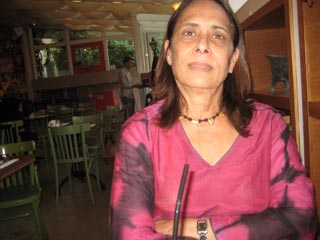
Linda Rivkind, a Baghdadi from Calcutta, is the rare Indian with a direct connection to the Holocaust.
Linda's father, a Polish refugee, wound up in Calcutta sometime around 1940, when his ship developed engine trouble. The Jewish community of Calcutta took him in, and he stayed on. “He bought a lot of books about the Holocaust,” Rivkind recalled over coffee in Jerusalem’s legendary Smadar café and movie theater, with its the dramatic posters appropriate to her story. “One book I happened to pick up, The Black Book of Poland, was quite horrifying. I understood then that this was what happened to my father’s family. It was so grotesque, I was completely unprepared for it. I think I was 12 at the time.”
Why did India’s Jews leave their native country for a land born in warfare and hemmed in by a hostile Arabia? The Jews of India, like everyone in India, took their faith seriously. “We were always facing Jerusalem in prayer,“ Judah said, “and praying, ‘Next year in Jerusalem.’ When the Jewish state was formed, we had to go.”
One who did not go was Brigadier David Abraham, Judah’s father. She remembers him cursing her, saying, “Why do you leave India? This is our country. It’s given us so much.”
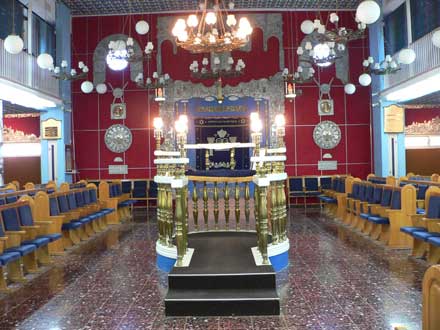
A Cochini synagogue at Moshav Nevatim in Israel. (Photo: Tirza Lavi)
The synagogues were the center of Cochini life. When the Bene Israel left for Israel, there were still no rabbis and no rabbinical laws. They practiced a pared down Judaism: they prayed the Shema, the central prayer of Judaism, practiced circumcision, kept kosher, and as mentioned before, kept the Sabbath.
There were more mundane issues involved in the Jews leaving India. A disproportionate number of Bene Israel served as officers in the British Army. They had acquired a reputation for loyalty. As a result, according to historian Nissim Moses, an Indian Jew, the Bene Israel were treated as a favored community. While they continued to serve in the Army of India, inevitably the plum jobs that had been given to them by the British went mainly to Hindus.
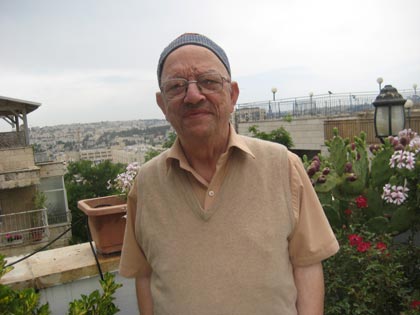
Ephry Yona comments on how the Baghdadis were the most insular and British-influenced of the three Jewish communities in India.
The Baghdadis were the most insular and British-influenced of the three communities. “Our first language was English,” laughed Ephry Yona, a 72-yearold Jerusalemite in a multi-colored skullcap, who in his working days was a chartered accountant. “We adopted British customs. Some even took British names. We of course felt our interests were with the British.”
The wealthy Baghdadis, with a few exceptions, migrated to England, Canada, and the U.S. Only a few of the wealthy went to Israel. The Baghdadi middle class did go, brought to Israel by the Jewish Agency in the early 1950s.
An understandable nostalgia
Yona’s father owned a jute mill in
a town close to Kolkata. He was sent to
England to study, then went to Canada,
before coming to Israel. He shares with
other Baghdadis an understandable nostalgia
for the old Calcutta. “The community
was like one big family, which in one
respect wasn’t so good. Everyone knew
everyone else’s business. But we had a
big house, big grounds, a gardener, even
a security guard.” He also had a mother
who starred in silent films in Calcutta in
the late-1920s and early-1930s under the
name of Arati Devi.
Over all, very few Indian Jews were affluent. The Cochinis, for example, included many small shopkeepers. The Bene Israel gravitated to the professions: teachers, lawyers, engineers, soldiers, and doctors. Daniel Reuven, an engineer from the seaside town of Bat Yam, is enduringly humbled by the fact that his grandfather’s cousin, Dr. Solomon Abraham Erulkar, was Gandhi’s physician. By and large, they wound up doing those same jobs in Israel. Similarly, a number of the English-speaking Baghdadis who were clerks in India found themselves employed as clerks in the Israeli customs offices, at the airport in Lod.
With the Cochinis it was different. Townspeople who dealt in goods and services (and were less proficient in English), they were sent to work as farmers in settlements in the South, the North, and by the Jordanian border near Jerusalem, where they replaced the Yemenites who had grown tired of the armed incursions from Jordan.
The Cochinis were the darkest-skinned immigrants in Israel at the time. The country was run by the Labor Party, Europeans with socialist tendencies, but questionable sensitivity to non-whites. Yehuda Abraham, a second-generation Cochini married to an American, complained of hostile looks in the street as a boy, of being made to feel different. However, most Cochinis deny being discriminated against. And it can be argued that being sent to do rural labor was no indication of racism in a country that was still enthralled by the Zionist idea of the rural Jewish settler, the pioneer.
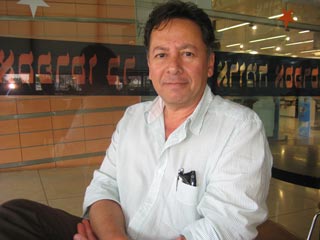
Yitzhak Ashkenazy, an associate at the Indian Jewish Heritage Center, talks about political affiliations of Indian Jews.
In the three-story Sheva Cochavim (Seven Stars) mall in Herzliya, a cathedral of hyper Israeli consumption, Yitzhak Ashkenazy, a middle-aged Baghdadi businessman, and also an associate at the Indian Jewish Heritage Center, talked politics between bites of his tuna fish salad. “Indian Jews in Israel tend to be right of center. (Israel today is a right-of-center country.) Many tend to be religious. Also, like many Eastern Jews, they associate the left with the Labor Party that they feel neglected them. But it is wrong to generalize about any community. I myself happen to be left of center.”
In his case, that is no small fact. Ashkenazy was in the Jamil Restaurant in Herzliya in 2002 when a Palestinian terrorist detonated a pipe bomb killing a young girl and shattering his son’s eye. His wife, an Argentine immigrant who until then voted for left wing Meretz, has ever since voted for right-wing Likud. But Ashkenazy continues to hope for a peace candidate, even though he is now doubtful that the other side wants peace. He takes in stride, like most Israelis, including Indians, the culture of risk that is a normal part of life here.
Israel’s best-known and most controversial peace activist of the 1960s and 1970s, Abie Nathan, was a Baghdadi who grew up in Bombay. In 1966, he flew solo to Port Said to talk peace with Egyptian President Nasser. He was arrested in Port Said and returned to Israel, where he was arrested again. In the ’70s he inaugurated his peace ship, aptly named Voice of Peace, in international waters, from which he broadcasted lively music and peace programming to the Middle East.
Unknown to many outside Israel is an ongoing cultural event that may be called, for lack of a better term, the India phenomena. Every year, Israeli soldiers, upon finishing military service, journey to India to free themselves from the pressure cooker of Israel, to lose themselves in India’s vastness and non-judgmental chaos, its tolerance of what the stranger brings to its shores. Nevertheless, these soldiers have little interest in the Indians living among them, possibly because Israel’s Indian Jews tend to be reserved, cooperative, model citizens. They don’t complain or draw attention to themselves. The large number of Indians in Israel often comes as a surprise to Israelis.
Rite of passage
The sons and daughters of Indian Jews join in the national rite of passage to India. It has become the vehicle through which second- or third-generation Indian-Israelis re-connect with India. Children born to Indian parents in the 1950s or 1960s may still speak some Marathi or Malayalam. But that may not last long. Assimilation is inescapable in a beleaguered country in need of unity. Everyone learns Hebrew, serves in the army, is imprinted with an Israeli-Jewish identity. An Indian who does not have a single anti-Semitic memory will live within the emotional centrality of the Holocaust in Israeli life.
Greenfield’s son Ari, in his early 20s, typically had little interest in India as a young Israeli. “After the army, he went to India. He saw the synagogue in Cochin that has the original Copper Plates. Something clicked. He said, ‘Mom, this is what we have in our living room.’ He had been looking at our replicas of the Copper Plates all his life. All of a sudden his Indian heritage became real to him.”
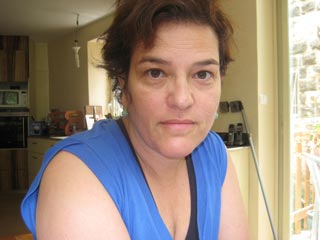
Even though Canadian born, Rachel Yona was always aware of her Indian roots.
Unlike Ari Greenfield, Rachel Yona, 49, Ephry Yona’s daughter, was always aware of her Indian roots. Canadian-born, she grew up with her “very Indian” grandfather in Hamilton, Ontario, and Jerusalem. “We ate only Indian food,” said the yoga instructress. “My grandfather lived in India for the first 60 years of his life and always went back, returning with jewelry and artifacts.”
Cool to her father’s Jewish orthodoxy, Rachel Yona was a lot like the spiritually disaffected young Westerner that India normally attracts. She went to India for the first time at age 24, a few years after completing military service. She found herself at the Rajneesh Ashram in Pune: “Very Western, very materialistic.”
Her encounter with Ram Surat Kumar in Tiruvannamalai, a few years later, had a much greater impact on her. “I sat with him every day. He would look at me and say, ‘You have all this information in your (Jewish) books. You should be looking in your own books.’ Sometimes he would ask me, ‘What does Judaism say about this?’” She was staying at the Ramana Maharshi Ashram across the road with its big library. She began reading its Jewish books. So, ironically, in this advaita corner of Tamil Nadu she became a practicing Jew, lighting candles on the Sabbath, saying the traditional Sabbath prayers.
From Puttaparthi, intoxicated with openness, she mentioned to her parents that Sai Baba used the same words as Jesus in his talks. “That worried them. They thought she is Hindu and Christian now!”
Avishai Judah, 21 and just done with military service, has no desire to go to India. “I have India in the house. I don’t need to go there.”
Indian Jews for the most part are adaptable émigrés. They have adapted well to Israel, but there have been difficulties. Greenfield, arriving in 1984, went from affluence to poverty. “I had six or seven servants in Delhi. I moved into immigrant housing in Ramat Aviv. I had to share a flat with a Russian roommate. Even going to bathroom in the morning was a problem. It was very hard.”
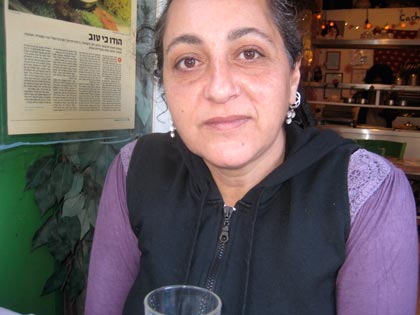
Lahava Silliman, owner of Ichikidana, an Indian restaurant in West Jerusalem.
Lahava Silliman, in her late 40s, and the owner of Ichikidana, an Indian restaurant in West Jerusalem, had a problem with the aggressiveness of Israeli society, a problem she still wrestles with. “When I first arrived in Israel,” (her mother immigrated with her from Calcutta when Silliman was 17) “it took me a half hour to board a bus because I wouldn’t push.”
Judah, 23 when she emigrated, reflected, “Adjusting to new country can be compared to the Indian bride leaving her mother’s house to live with her husband. You have to change. There are things you have to forget.”
The good relations enjoyed by Jews and Muslims in India is something they remember. The Bene Israel often ate at Muslim homes, and had Muslims come to eat at their own homes. In Calcutta, Muslims became the caretakers of the three synagogues, no longer in use, and the Jewish Cemetery of Calcutta, very much in use. It is mainly Muslim girls who attend the private Jewish Girls School, where they must remove their hijabs before entering. Cochini Jews recall the respect and tolerance Muslims had for their religion.
“In India,” recalls Nissim Moses, “religion was a minor factor in building relations with a friend. Everyone in India celebrated everyone else’s festivals. In Israel, on the other hand, you will rarely find Jews and Arabs mixing with each other.”
Being mainly a middle-class community, Israel’s Indians have not benefited directly from the boom in India- Israeli trade relations since the two countries established diplomatic relations in 1992. Trade has grown since then from $ 200 million a year to $ 5.5 billion a year at the end of 2011. Diamonds are India’s biggest export to Israel, while military equipment is the most prominent item Israel exports.
Eliyahu Bezalel exported something more important than his flowers to India in the nineties: he exported his successful greenhouse technology that included drip irrigation, making seedlings compatible with particular kinds of soil, gauging the tension between soil and water. He imported this technology personally, charged nothing for it, and was happy merely to do his part to help Indian agriculture along.
“I traveled to horticultural conventions in India, and Indians traveled to Shachar to visit my greenhouse.” Eliyahu wears his Indian skin more boisterously than most Indian-Israelis. Even before he was honored with the Pravasi Award, he received an honor that seemed to thrill him more. He was invited to sleep in the bed Prime Minister Nehru had slept in when the latter visited the Hirakud Dam in Orissa. “My parents would have been so proud!”
Robert Hirschfield is a New-York based freelance writer whose work has appeared in Outlook, Sojourners, Matador, and other publications.
Enjoyed reading Khabar magazine? Subscribe to Khabar and get a full digital copy of this Indian-American community magazine.
blog comments powered by Disqus










